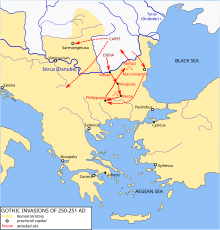This article needs additional citations for verification. (November 2024) |
| Millennium: | 1st millennium |
|---|---|
| Centuries: | |
| Decades: | |
| Years: |
| 251 by topic |
|---|
| Leaders |
| Categories |
| Gregorian calendar | 251 CCLI |
| Ab urbe condita | 1004 |
| Assyrian calendar | 5001 |
| Balinese saka calendar | 172–173 |
| Bengali calendar | −343 – −342 |
| Berber calendar | 1201 |
| Buddhist calendar | 795 |
| Burmese calendar | −387 |
| Byzantine calendar | 5759–5760 |
| Chinese calendar | 庚午年 (Metal Horse) 2948 or 2741 — to — 辛未年 (Metal Goat) 2949 or 2742 |
| Coptic calendar | −33 – −32 |
| Discordian calendar | 1417 |
| Ethiopian calendar | 243–244 |
| Hebrew calendar | 4011–4012 |
| Hindu calendars | |
| - Vikram Samvat | 307–308 |
| - Shaka Samvat | 172–173 |
| - Kali Yuga | 3351–3352 |
| Holocene calendar | 10251 |
| Iranian calendar | 371 BP – 370 BP |
| Islamic calendar | 382 BH – 381 BH |
| Javanese calendar | 129–130 |
| Julian calendar | 251 CCLI |
| Korean calendar | 2584 |
| Minguo calendar | 1661 before ROC 民前1661年 |
| Nanakshahi calendar | −1217 |
| Seleucid era | 562/563 AG |
| Thai solar calendar | 793–794 |
| Tibetan calendar | 阳金马年 (male Iron-Horse) 377 or −4 or −776 — to — 阴金羊年 (female Iron-Goat) 378 or −3 or −775 |

Year 251 (CCLI) was a common year starting on Wednesday of the Julian calendar. At the time, in the Roman Empire, it was known as the Year of the Consulship of Traianus and Etruscus (or, less frequently, year 1004 Ab urbe condita). The denomination 251 for this year has been used since the early medieval period, when the Anno Domini calendar era became the prevalent method in Europe for naming years.
